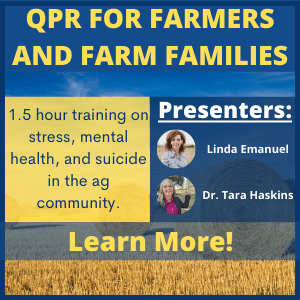Last updated on February 13th, 2023 at 02:24 pm
Musculoskeletal Resources
Musculoskeletal disorders (MSDs) affect the muscles, nerves, blood vessels, ligaments, and tendons. Farm and ranch workers can be exposed to risk factors at work, such as lifting heavy items, bending, reaching overhead, pushing and pulling heavy loads, working in awkward body postures, and performing the same or similar tasks repetitively. Exposures to known risk factors for MSDs increases a risk of injury.
Ergonomics is simply “fitting the task to the worker” rather than forcing the worker to fit the task. Applying ergonomic principles to workstations can help prevent a variety of conditions, such as back pain, shoulder pain, neck pain, and hip pain. Ergonomic principles are based on a combination of science and engineering and a thorough understanding of human capabilities and limitations. When these principles are applied to the design of a job, task, process or procedure, the risk of injury is significantly reduced.
The lower back is the most common site of back injuries and back pain and may include sprains and strains, herniated disks, and fractured (broken) vertebrae. These injuries can cause pain and limit your movement. To save your back, practice good lifting and carrying habits.
Whole body vibration (WBV) occurs when vibrations from a vehicle or power tool transfer to the human body. Over time, WBV can impair speech, increase heart rate, breathing rate and blood pressure, cause muscle fatigue and cramping, disrupt balance and perception, and cause lower back pain. Read about prevention strategies to address WBV.
Good posture is an important part of your long-term health, and the key is the position of your spine while in a dynamic or static posture. Dynamic posture is how you hold yourself when you are moving while walking, running, or bending. Static posture is how you hold yourself when you are not moving, such as when you are sitting, standing, holding a tool in place, and sleeping. Correct posture should maintain the three natural curves in the spine from the neck to the low back. Your head should be above your shoulders, and the top of the shoulders should be over your hips.
Posture Improvement Suggestions:
- Be mindful of your posture while doing daily activities at the workbench, desk and while sitting in a tractor or other equipment seats.
- Stay active. Regular exercise to stretch, condition and/or increase body awareness such as Yoga and or Pilates. Exercises that strengthen your core (muscles around your back, abdomen, and pelvis) are advisable. Learn about poses that make you ready to farm.
- Maintain a healthy weight. Extra weight can weaken your abdominal muscles causing stress on your pelvis and spine contributing to low back pain.
- Wear comfortable, low-heeled shoes. Work boots with low heels and good ankle support will aid in balance and correct posture.
- Make sure your work surface at home and work are at a comfortable height. When sitting at your desk or in a tractor seat, your low back should be comfortably positioned against the back rest of the chair with feet flat on the floor. A pillow or rolled-up-towel placed behind the small of the back can provide some lumbar support if needed. Arms should align and rest comfortably at your sides. Switch sitting positions often and periodically walk around the office or tractor to gently stretch muscles to relieve neck, shoulder, arm and back tension.
Farm/Ranch Equipment Ergonomics Suggestions:
- Anti-fatigue matting. Place in front of workbenches.
- Adjustable tables with rollers. Adjust to fit mobile workspace and height of worker.
- Adjustable office chair. Always try a chair before you purchase to determine individual comfort. Be sure the height of the desk chair allows your feet to rest flat on the floor.
- Articulating keyboard trays, mouse, lumbar cushions and document holders. Choose a keyboard tray adjustable to the height and position of the user.
- Handle coatings or special gloves. These help suppress vibrations from power tools.
- Anti-vibration tractor seats. Consider anti-vibration seats to retro-fit tractors.
Musculoskeletal Resources
Fact Sheets and Guidebooks
| ID | Title | Summary | Link |
|---|---|---|---|
| 9372 | A Guide to Selecting Non-Powered Hand Tools | CDC resource guide on non-powered hand tools. | |
| 9369 | A Health and Safety Solution: Using Office Areas | Tips for computer usage in office areas. | |
| 12761 | AgriSafe Yoga | Yoga for strengthening and flexibility – examples given in farm settings. | |
| 8937 | Back Injury Prevention Tips | This is a guide produced by the National Education Center for Agricultural Safety (NECAS) on back injury prevention tips for workers in agriculture. | |
| 11466 | Back Pain Can Be Attributed to Whole-Body Vibration | An article from Successful Farming | |
| 12345 | Concerns for Older Adults Working in Agriculture | episode of Talking Total Farmer Health | |
| 17898 | How Ergonomic Technology Can Improve Farm Safety | episode of Talking Total Farmer Health | |
| 9366 | Listos para trabajar | Poses to improve muscle strength and flexibility – examples given in farm settings. | |
| 12758 | Pilates AgriSafe | Pilates for strengthening and flexibility – examples given in farm settings. | |
| 8939 | Pilates Poster | Pilates for strengthening and flexibility – examples given in farm settings. | |
| 8222 | Prevention of Falls in the Transport of Livestock | The information in this guide has been written specifically for the livestock industry to prevent falls when transporting livestock. | |
| 9364 | Ready to Farm Poster | Poses to improve muscle strength and flexibility – examples given in farm settings. | |
| 12771 | Recomendaciones para prevenir lesiones en la espalda | This is a Spanish language guide produced by the National Education Center for Agricultural Safety (NECAS) on back injury prevention tips for workers in agriculture. | |
| 16059 | Rural Telehealth – Part 1 of 2 | episode of Talking Total Farmer Health | |
| 16060 | Rural Telehealth – Part 2 of 2 | episode of Talking Total Farmer Health | |
| 9370 | Simple Solutions: Ergonomics for Farm Workers | This guide shows simple changes agricultural workers can make to improve ergonomics. | |
| 9375 | Soluciones Simples: Ergonomía Para Trabajadores Agrícolas | This Spanish language guide shows simple changes agricultural workers can make to improve ergonomics. | |
| 13305 | The National AgrAbility Project | episode of Talking Total Farmer Health | |
| 9373 | Una Guía para la Selección de Herramientas de Mano No-Energizadas | CDC resource guide in Spanish on non-powered hand tools. English Title: A Guide to Selecting Non-Powered Hand Tools | |
| 9371 | Whole Body Vibration Handout | Resource focusing on whole body vibration – GPCAH | |
| 9902 | Working in Agriculture in Snow: Preventing Slips, Trips, and Falls | Listen to these tips from AgriSafe staff member Linda Emanuel as she discusses a few tips for staying safe while working on the farm in the snow! | |
| 9362 | Yoga Poster | Yoga for strengthening and flexibility – examples given in farm settings. | |
| 10347 | Yoga the AgriSafe Way: Grain Bin Edition | Yoga exercises specifically designed for farmers and ranchers. Your body is a tool be sure to take care of it properly! Check out these yoga moves using a grain bin. | |
| 10346 | Yoga the AgriSafe Way: Truck Edition | Yoga exercises specifically designed for farmers and ranchers. Your body is a tool, be sure to take care of it properly! Check out these yoga moves incorporating a farm truck. | |
| 10345 | Yoga the AgriSafe Way: Wall Edition | Yoga exercises specifically designed for farmers and ranchers. Your body is a tool be sure to maintain it! Check out how a wall can be used to stretch and strengthen your body. |
Webinars
| Webinar Title | Summary | Link |
|---|---|---|
| Chainsaw Safety Training | The Chainsaw Safety training program is intended for workers and managers in the agricultural and forestry industries. The major focus of the program is on the identification of and the safe operation of chainsaws. According to the Centers for Disease Control and Prevention (CDC), approximately 36,000 people are injured by chainsaws annually. | |
| Discovering the Root of your Back Story: Prevention and Understanding of Back Injuries (December 10, 2020) | Back injuries are one of the most common forms of farm-related injuries, so protecting the back is one of the most important things a producer can do to stay active on the farm. Men and women are both prone to work-related back pain and the first episode usually occurs between the ages of 20 and 40. Training will focus on effects of whole body vibration, causes of back injuries/pain, how to prevent back injuries/pain, and other considerations. | |
| Ergonomic Safety for Farm Women (December 1, 2020) | It is no secret – women are playing an increased role in production agriculture. They account for about one-third of the management, ownership and work on farms, ranches and in crop production. A major challenge continues to be access to protective equipment that meets the ergonomic needs of women. This program is intended to help women in rural/agricultural communities identify ergonomic issues leading to musculoskeletal injuries in farm and ranch work and discover resources to aid in injury prevention. | |
| Hearing Loss Prevention for Forest Workers | Hearing loss is common, especially among workers who are exposed to hazardous noise where they work. Forestry and Logging are among the top industry sectors for worker exposure to hazardous noise that can contribute to hearing loss. According to The National Institute for Occupational Safety and Health (NIOSH), noise-exposed workers in Forestry and Logging had a higher percentage of hearing loss (21%) than all noise-exposed industries combined (19%). This training will discuss effective methods for preventing hearing loss from noise in … | |
| Musculoskeletal and Ergonomic Safety for Forest Workers | Forest workers face unique ergonomic challenges due to their exposure to extreme environmental conditions, heavy workload, and dangerous tools and machines. The forest sector has one of the highest rates of Musculoskeletal Disorders (MSDs), almost 100 times higher than the industrial targets the National Institute for Occupational Safety & Health (NIOSH) set. This program is intended to help forest workers identify ergonomic issues leading to musculoskeletal injuries and discover resources to aid in injury treatment and prevention. | |
| The Ergonomics of Hand Planting Reforestation Work | Reforestation work is vital to the health of America’s forests and the U.S. economy. Hand planting, a common reforestation practice, provides unique challenges to safety and health practitioners interested in reducing occupational injuries and illnesses. This webinar will share lessons learned from a team of investigators studying occupational exposures to physical risk factors among hand planters in the Southeastern United States. |
Page updated: August 2022




